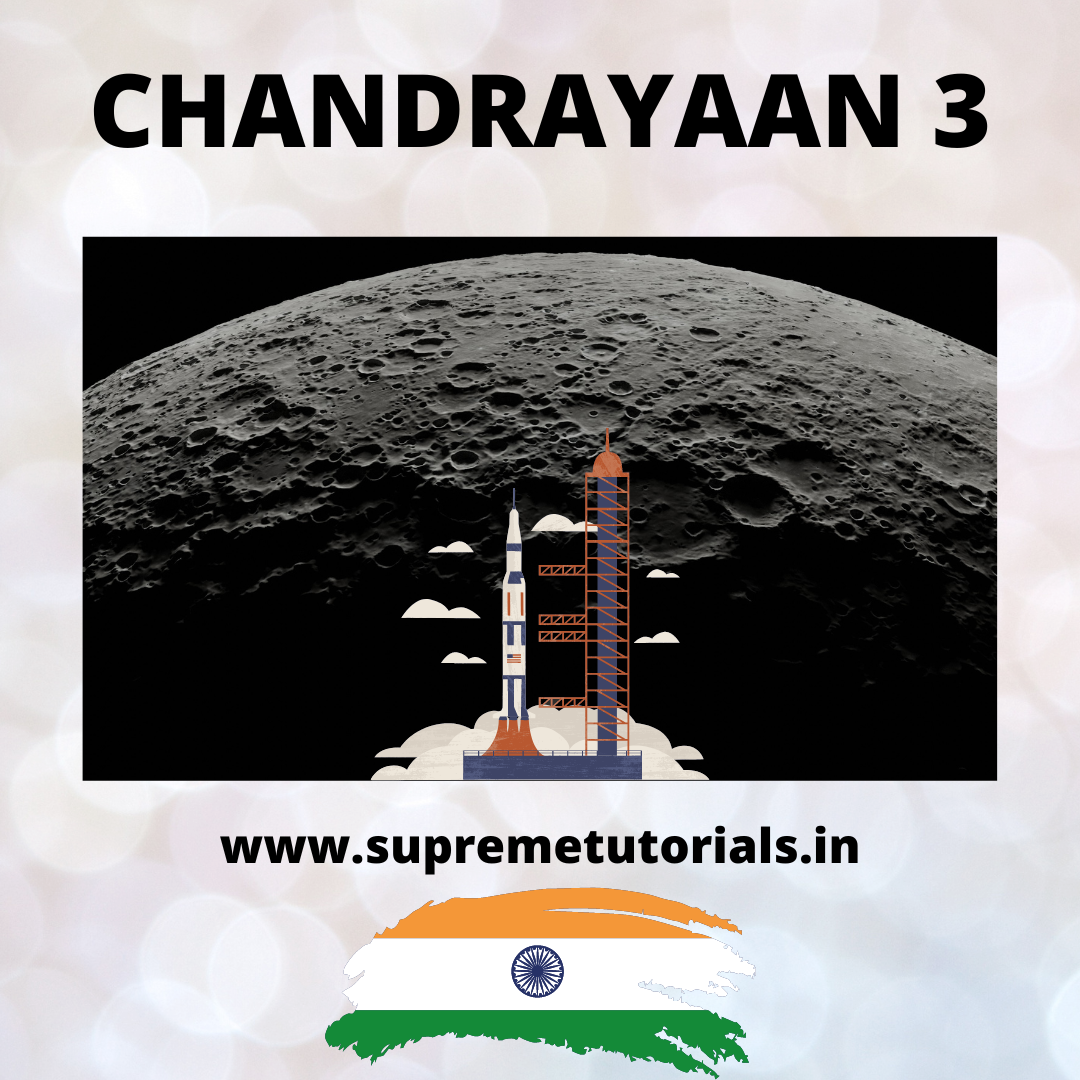Chandrayaan 3
The Chandrayaan 3 mission is an ambitious endeavor in celestial exploration, aiming to uncover the mysteries of the Moon’s South Pole. This article offers a glimpse into the significance and potential discoveries of this groundbreaking Chandrayaan 3 mission.
Tracing the Moon’s History

The Moon serves as a faithful chronicle of the solar system’s history. By studying its geological features and composition, scientists can piece together a narrative of cosmic events that shaped not just the Moon but also Earth. Chandrayaan 3’s instruments are poised to analyze the Moon’s surface in unprecedented detail, offering clues about the intense volcanic activity it once experienced and the meteorite impacts that scarred its face.
Water, Water Everywhere?
One of the most tantalizing possibilities associated with Chandrayaan 3‘s mission to the Moon’s South Pole is the presence of water ice. Scientists have long speculated that the permanently shadowed craters in this region could be reservoirs of water ice, a resource of immense value for future lunar missions. Confirming the presence of water ice could not only support the sustainability of future lunar exploration but could also provide insights into the history of our solar system.
Unveiling the Lunar Mysteries
The Moon, though a constant presence in our night sky, has held its secrets close. Its South Pole, a region less explored, has long captivated the minds of scientists and astronomers. Chandrayaan 3, the brainchild of cutting-edge technology and human ingenuity, aims to change that. With a specific focus on the Moon’s South Pole, this mission holds the potential to uncover secrets about the Moon’s formation, its history, and even our own planet’s past.
Advancements in Technology
Chandrayaan 3 doesn’t just represent a scientific endeavor; it embodies technological advancement at its finest. From the precision of the launch vehicle to the intricacies of the onboard instruments, every aspect of this mission showcases the prowess of modern engineering. The lander-rover duo, equipped with state-of-the-art sensors and analytical tools, promises to beam back data that could reshape our understanding of lunar geology and evolution.
Chandrayaan 3: A Glimpse of the Mission
Unveiling the Objectives
Chandrayaan 3 is a pioneering lunar mission with objectives focused on exploring the moon’s surface, topography, mineral distribution, and identifying the presence of water molecules.
Technological Marvels
ISRO’s prowess in engineering and innovation shines through in Chandrayaan 3. The mission will comprise a lander and a rover, each equipped with advanced scientific instruments. These instruments are designed to capture high-resolution images, analyze soil composition, measure seismic activities, and assess the presence of Helium-3 isotopes—a potential fuel for future fusion reactors.
ISRO’s Stalwart Efforts
Upholding Excellence
ISRO’s Chandrayaan 3 mission highlights their commitment to excellence in space exploration, with meticulous planning, advanced technology, and unwavering dedication.
Collaborative Ventures
ISRO’s collaborations with international space agencies have been crucial for the success of Chandrayaan missions, fostering knowledge exchange and a shared pursuit of understanding the mysteries of the universe.
Chandrayaan 3: Overcoming Challenges
Navigating Lunar Terrain
Chandrayaan 3 is a remarkable spacecraft designed to overcome the obstacles of the lunar surface, including rough terrains, fluctuating gravity, and extreme temperatures. Its innovative engineering enables it to navigate and conduct scientific research effectively in this challenging environment.
Learning from Predecessors
The lessons learned from Chandrayaan 1 and 2 have been invaluable in shaping the trajectory of Chandrayaan 3. These missions, while marking significant milestones, also provided insights into areas for refinement. Chandrayaan 3 is a culmination of experience, expertise, and evolution.
The Path Ahead: Chandrayaan 3’s Significance
Advancing Lunar Science
Chandrayaan 3 is poised to contribute significantly to lunar science. The extensive data collected during the mission will enable scientists to unravel the moon’s geological history, its connection to Earth, and the broader evolutionary processes that have shaped celestial bodies.
Future Exploration Prospects
Beyond the immediate scientific gains, Chandrayaan 3 paves the way for ambitious future endeavors. The mission’s findings will influence the planning of subsequent lunar missions, including potential manned missions and the establishment of lunar bases. Chandrayaan 3’s impact reverberates through time.
A Stepping Stone for Humanity
Beyond the scientific and technological achievements, Chandrayaan 3 represents humanity’s relentless spirit of exploration. Each mission to the Moon builds upon the knowledge of the past, propelling us toward a future where interplanetary travel might become a reality. The insights gained from this mission could serve as a stepping stone for the ultimate goal: sending humans to walk on the lunar surface once again.
The International Stage
Chandrayaan 3 isn’t just an endeavor confined to a single nation; it’s a testament to international collaboration. As countries across the globe pool their resources and expertise, the mission becomes a symbol of unity in the pursuit of knowledge. This shared venture amplifies the potential for discoveries that benefit all of humanity, transcending borders and boundaries.
FAQS
Certainly, India is not the first country to reach the moon. The United States achieved this milestone on July 20, 1969, when the Apollo 11 mission successfully landed astronauts Neil Armstrong and Edwin “Buzz” Aldrin on the lunar surface. They became the first humans to set foot on the moon. Subsequently, other countries, such as the Soviet Union (now Russia) and China, have also conducted successful lunar missions, including orbiters, landers, and rovers. India joined this list with its Chandrayaan-2 mission, which included an orbiter, lander, and rover, launched in July 2019, although the mission’s lander experienced a hard landing and the rover didn’t deploy.
Chandrayaan-3 is successfully landed in the south pole of lunar surface on 23 aug,2023.
Yes,Chandrayaan-3 is successfully landed in the south pole of lunar surface on 23 aug,2023.
40 days.
Chandrayaan-2, India’s lunar mission launched in July 2019, aimed to study the Moon’s south pole and land a rover. However, during the landing attempt, communication with the lander (Vikram) was lost due to a software glitch. The mission’s orbiter is operational and sending data, despite the lander’s failure.
No Indian astronauts have landed on the moon Yet. India’s space agency, ISRO (Indian Space Research Organisation), has launched lunar missions, such as Chandrayaan-1 and Chandrayaan-2, which aimed to explore the moon and its surface. However, these missions were focused on orbiter and lander modules, rather than crewed missions.
India’s lunar mission, such as Chandrayaan-2, takes around 40 days to reach the Moon due to a combination of factors involving orbital mechanics and mission design.
- Energy-efficient Transfer Orbit: To conserve fuel and energy, spacecraft are launched into an elliptical orbit around the Earth. From this initial orbit, a carefully calculated maneuver is performed to gradually increase the spacecraft’s distance from the Earth and align its trajectory with that of the Moon. This transfer orbit, known as the Hohmann transfer orbit, is energy-efficient but takes time to reach the Moon.
- Gravity Assist: In some cases, missions take advantage of gravity assist maneuvers, where the spacecraft uses the gravitational pull of other celestial bodies, like the Moon itself, to help it gain velocity and adjust its trajectory. This can add complexity to the mission but can save fuel and time.
- Slow but Steady Approach: Spacecraft usually take a gradual approach to the Moon to ensure that they can accurately insert themselves into lunar orbit without using excessive fuel. This gradual approach involves a series of engine burns to adjust the spacecraft’s velocity and position.
- Minimizing Risk: Space agencies, including the Indian Space Research Organisation (ISRO), prioritize safety and accuracy in their missions. Taking a more measured approach to reach the Moon helps reduce the risk of mishaps during critical maneuvers.
- Limited Thrust: Spacecraft engines, especially those used for deep space travel, may have limited thrust compared to the powerful engines used for launch. This affects how quickly a spacecraft can change its velocity and trajectory.
- Scientific Objectives: Lunar missions like Chandrayaan-2 are not just about reaching the Moon quickly; they also have scientific objectives, such as studying the Moon’s surface, composition, and environment. Taking the time to enter the desired lunar orbit allows the spacecraft to fulfill these scientific goals effectively.
Summary
In the grand tapestry of space exploration, Chandrayaan 3 shines as a jewel in ISRO’s crown. With its meticulous planning, technological brilliance, and collaborative spirit, the mission exemplifies humanity’s indomitable quest for knowledge and discovery. As Chandrayaan 3 sets forth on its lunar journey, it carries with it the aspirations of a nation and the curiosity of a species eager to uncover the secrets of the cosmos.







Thanks for sharing. I read many of your blog posts, cool, your blog is very good.
Thank you for your sharing. I am worried that I lack creative ideas. It is your article that makes me full of hope. Thank you. But, I have a question, can you help me?
Dry Cleaning in New York city by Sparkly Maid NYC
Concierge-quality cleaning, treats our penthouse with proper care. You understand high standards. Luxury delivered.
Thank you for your sharing. I am worried that I lack creative ideas. It is your article that makes me full of hope. Thank you. But, I have a question, can you help me?
Thanks for sharing. I read many of your blog posts, cool, your blog is very good.
Very interesting subject, thank you for posting.Raise your business